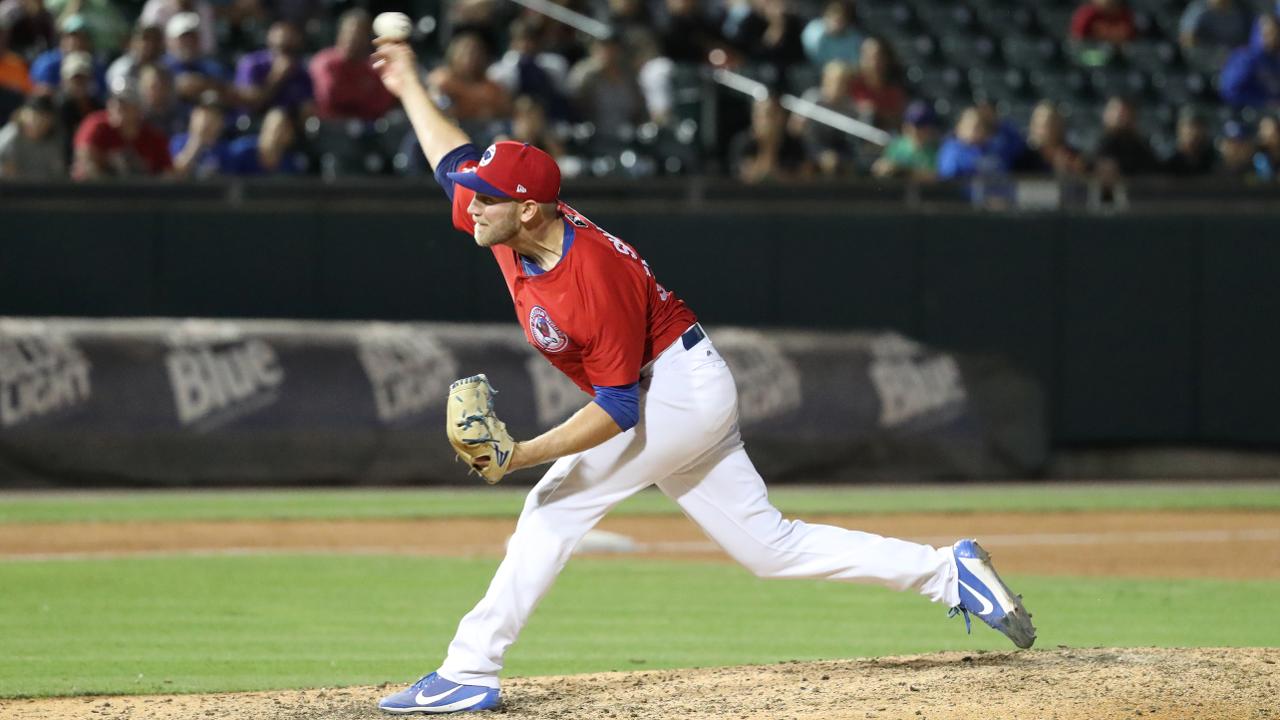STAFF REPORTS

BUFFALO, N.Y. — Justin Shafer emerges from the dugout and after taking his first step onto the field, he paces steadily toward the first base line.
He peers out into the outfield, looks down and grabs a baseball and a blue fungo bat outfitted with a black grip–an elongated and hollowed out training bat commonly used for fielding practice.
Shafer, donning a blue practice jersey etched with the Bisons’ logo on the front and his No. 33 in red on the back, tosses the ball up in the air and slashes groundballs to his teammates in the infield during batting practice.
Ask Shafer and he’ll say the procedure isn’t exactly a time-tested ritual–it’s just something he picked up and started doing recently after being unofficially anointed the task by Bisons’ manager Bobby Meacham. He laughed about it and remarked that it keeps him swinging the bat and perhaps, helps him loosen up for golf in the offseason.
One thing, however, that Shafer has plenty of experience with is toeing the rubber during late-inning situations–and he has been spectacular in that capacity.
This season with the Herd, Shafer has made 25 appearances and has pitched 28.1 innings while garnering a sub-two ERA. He has held opposing hitters to a stunning .168 batting average.
The right-handed pitcher arrived in Buffalo for the first time last season after climbing through the Blue Jays’ Minor League system. He started the 2017 season with the High-A Dunedin Blue Jays and in 2018, he made 13 appearances with the Double-A New Hampshire Fisher Cats before receiving a promotion to return to the Bisons.
Shafer, who hails from Lake Wales, Fla., opted to stay in-state to play college baseball for the perennial powerhouse University of Florida where he functioned as both a hitter and a pitcher for the Gators.
Shafer charted his course to enter the MLB Draft as a pitcher, but it wasn’t until very late in his college career that he started to focus solely on the position.
“I knew I was going to be a pitcher,” he said. “The last month I started throwing a lot in college even though I wouldn’t really do the pitching stuff.”
He was in fact drafted by the Blue Jays as a pitcher in the eighth round of 2014 MLB Draft following his junior season of college.
In the early years of his Minor League career, Shafer primarily operated as a starter but was converted to be groomed as a full-time reliever at the beginning of the 2017 season.
At first, he wasn’t too keen on making the switch to the bullpen, but he has since come to embrace his new job.
“Whenever I first got converted I was not looking forward to [being] in the bullpen just because I like having the routine of a [starter] pitcher,” Shafer said. “…Up front it was definitely an adjustment and not something I was looking forward to at the time but now it has grown to be where I actually like being a reliever better.”
One such adjustment was altering his delivery to only pitch from the stretch as opposed to working from both the windup and the stretch. This allowed him to remedy a problem he encountered as a starter: walking too many batters.
“I just went straight out of the stretch just to try to make it simpler, be able to repeat more and try to throw more strikes,” he said.
This season, he has nearly double the number of strikeouts (21) than he has walks (12).
Shafer also commented on one major difference he has experienced in terms of his game preparation since he transitioned to entering games out of the bullpen.
“The only difference is the workout part of it,” he said. “As a starter, you work out every day other than the day you are starting… Now I lift only the day after I throw.”
As a reliever, Shafer said his mindset on the hill is altered.
“As a starter, you are obviously trying to get deep in the game, more pacing yourself,” he noted. “Versus now one inning, two innings, I’m just going out, blowing it out [and] trying to get back in the dugout as quick as possible.”
With the Bisons, Shafer fills the vital role of the closer and leads the team with nine saves in 10 save opportunities this season. He is entrusted to get three swift outs to seal a win in games that go down to the wire.
Being called to the mound in a tight situation doesn’t rattle Shafer. He understands that facing pressure is inherently part of his role as a reliever and can actually be beneficial for him.
“It only makes you better whenever you get put out there to see what you have against those (kinds) of situations,” Shafer said.
He can picture himself sticking with his newfound duty in the future. He pointed out, however, that pitchers are often thrown into middle-inning spots when they are first called up to the Major Leagues.
“Whatever opportunity I have to pitch at the next level, I am going to be happy about doing, obviously,” Shafer emphasized. “I definitely like being late into games like that and [having] a more direct impact on the outcome.”
Pitchers are living embodiments of repetition and muscle memory through mechanics but every so often, there is a small window for experimentation when it comes to tinkering with different pitches and grips.
“Playing catch every day, there’s a couple of times every once in a while, you might fool around with grips,” Shafer said. “For me, different spots on the ball for my sinker or my changeup, moving it around.”
The practice doesn’t always translate to the actual product on the field. Instead, it serves more as a mental note.
“Not that necessarily I would do it in the game but just to have a feeling of, ‘Hey, this might be something that could work down the road,'” he elaborated.
Shafer maintains that the best pitch in his repertoire is the most reliable tool for most pitchers-the fastball.
“I think if I get ahead, I can put away guys with my slider, but I have also been able to put away guys with my fastball,” he said.
Shafer’s plan on the mound remains fairly straightforward and it’s all about pitching to an advantage.
“I want to attack,” Shafer voiced confidently. “I want to try to put the most pressure on the hitter as possible and get him into a favorable count for me to be able to put him away with that fastball or slider.”
Shafer, at just 25 years of age, has plenty of baseball ahead of him. He has cemented himself as a trustworthy arm for the Bisons and has the makeup to be a quality relief pitcher when his time comes in Toronto.


